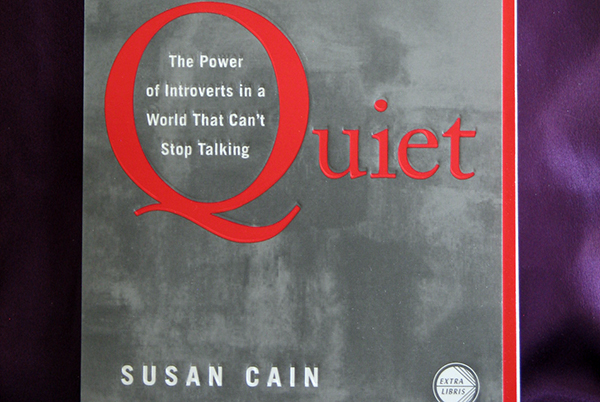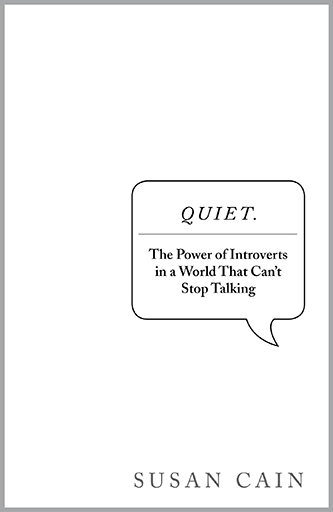Home »

A useful and thought-provoking book
Book Review
By Derryll White
Cain, Susan (2012). Quiet.
“In a gentle way, you can shake the world.”
–Mahatma Gandhi
Several people told me to read this book, both customers at Lotus Books and friends. I have never really thought of myself as an introvert, but I have also with some frequency sought and appreciated quiet places. Extroverts and introverts are personality types that go far back in human history to oral storytelling. Current thought lionizes extroverts – the athletic and celebrity personalities. It does us all well, however, to remember that half the world prefers listening to speaking, is creative but does not engage in self-promotion, and prefers working quietly by itself instead of forging ahead in teams. The quiet people simply are, and we all do well to remember that fact.
Susan Cain takes the reader on an interesting journey, into the self but also into the development and context of the culture we find ourselves in. As she labels it, there has been a shift from a Culture of Character to a Culture of Personality. She doesn’t judge – good or bad – rather she observes the shift from an inner to an outer-focused world. As she charts the shift in North American culture from contemplation to action she draws parallels with consumer and political culture. Cain does more to help me comprehend today’s world than do most political analysts I read and listen to.
 Cain substantively blows away many common modern day myths. ‘Multitasking’ – the brain is incapable of paying attention to two things at the same time so it switches back and forth, increasing mistakes by up to 50%. ‘Open-plan offices’ – reduce productivity and impair memory, and are associated with high staff turnover. Cain surprises me in so many different ways that she constantly delights and, at the same time, depresses me. I keep thinking, as I read, that we are headed toward a worse, not a better, world.
Cain substantively blows away many common modern day myths. ‘Multitasking’ – the brain is incapable of paying attention to two things at the same time so it switches back and forth, increasing mistakes by up to 50%. ‘Open-plan offices’ – reduce productivity and impair memory, and are associated with high staff turnover. Cain surprises me in so many different ways that she constantly delights and, at the same time, depresses me. I keep thinking, as I read, that we are headed toward a worse, not a better, world.
I find science a harsh master. Knowing that the amygdala, a small organ in the brain, can manufacture upsetting emotions such as the fear of rejection when one deviates from the norm is potentially depressing. It eliminates many from the act of dissent even when the herd is wrong. Perhaps unreasonably, this knowledge makes me want to stand even firmer in opposing many political and economic processes. But to what end, being a belligerent introverted iconoclast in a reality of organized extroverts?
Perhaps the single discovery in this book that made me happiest was the fact that Susan Cain in large part wrote it in a coffee shop. After all the studying, analysis and really intriguing insights into introversion, and ranking herself a prime introvert, she opted for the associative social interaction. She says, “I could toggle back and forth between observer and social actor as much as I wanted.” It is for that same reason that I read most of this book, and wrote this review, at my favourite coffee shop – Hot Shots. For me, creativity feeds off the peripheral social possibilities that environment brings into the frame.
Am I an introvert? Yep, I think so. Does it bother me – no! However, I did very much enjoy contemplating and wrestling with all of Susan Cain’s thought on the subject. This was a very useful and thought-provoking book.
“You once said that you would like to sit beside me while I write. Listen – in that case I could not write at all. For writing means revealing oneself to excess; that utmost of self-revelation and surrender, in which a human being, when involved with others, would feel he was losing himself, and from which, therefore, he will always shrink as long as he is in his right mind. That is why one can never be alone enough when one writes, why there can never be enough silence around one when one writes, why even night is not night enough.”
– Franz Kafka
****
Excerpts from the book:
THE EXTROVERT IDEAL – We live with a value system that I call the Extrovert Ideal – the omni-present belief that the ideal self is gregarious, alpha, and comfortable in the spotlight. The archetypal extrovert prefers action to contemplation, risk-taking to heed-taking, certainty to doubt. He favors quick decisions, even at the risk of being wrong.
INTROVERSION – along with its cousin’s sensitivity, seriousness and shyness – is now a second-class personality trait, somewhere between a disappointment and a pathology. Introverts living under the Extrovert Ideal are like women in a man’s world, discounted because of a trait that goes to the core of who they are.
THE BUSINESS CASE – “I worry that there are people who are put in positions of authority because they’re good talkers, but they don’t have good ideas. It’s so easy to confuse schmoozing ability with talent. Someone seems like a good presenter, easy to get along with, and those traits are rewarded. Well, why is that? They’re valuable traits, but we put too much of a premium on presenting and not enough on substance and critical thinking.”
CONNECTIONS – …it’s always been private occasions that make me feel connected to the joys and sorrows of the world, often in the form of communion with writers and musicians I’ll never meet in person. Proust called these moments of unity between writer and reader “that fruitful miracle of a communication in the midst of solitude.” His use of religious language was surely no accident.
INTROVERTS – “Most inventors and engineers I’ve met are like me – they’re shy and they live in their heads. They’re almost like artists. In fact, the very best of them are artists. And artists work best alone where they can control an invention’s design without a lot of other people designing it for marketing or some other committee.”
THE END WORD – “I am a horse for single harness, not cut out for tandem team work…
“Full well do I know that in order to attain any definite goal, it is imperative that one person should do the thinking and commanding.” – Albert Einstein
 – Derryll White once wrote books but now chooses to read and write about them. When not reading he writes history for the web at www.basininstitute.org.
– Derryll White once wrote books but now chooses to read and write about them. When not reading he writes history for the web at www.basininstitute.org.







